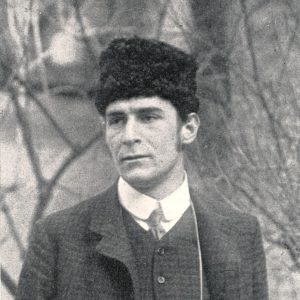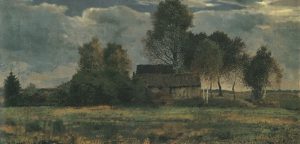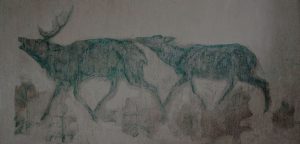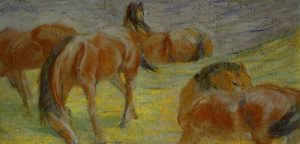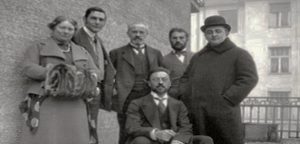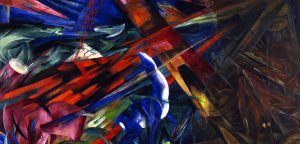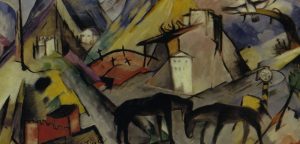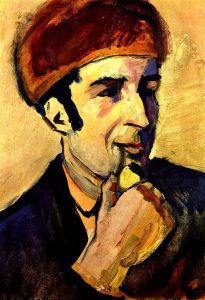He was born on the 8th of February in 1880 in Munich, Germany.
1880 - 1916
Franz Marc
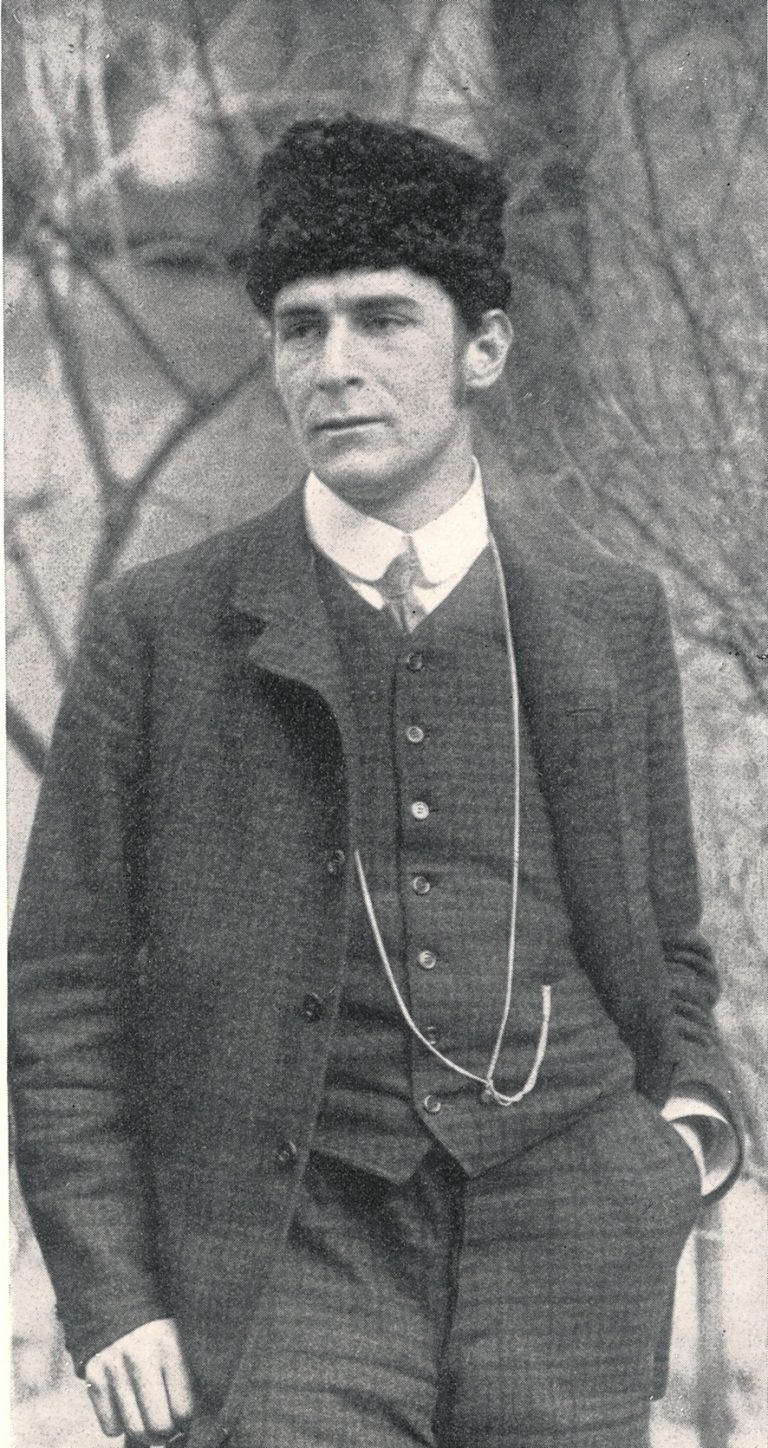
description
An outstanding German painter, the founder of Expressionism.
Born into the family of professional landscape painter Wilhelm Marc. His mother, a strict Calvinist, was from the French Switzerland – it was her, rather severe upbringing that made the boy serious and thoughtful.
The Expressionist movement became so famous because of its interest in the spirituality of the Symbolists, and also due to the harmonious combination of Primitivism, Fauvism and the vector into the flourishing abstraction. Franz Mark included all these styles in his painting style, adding love to theology and to the animal world. To create an alternative, more spiritual vision of the world, he depicted it through the view of animals that emphasized those aspects of modernity that he considered unfavorable. It is also important that his later works moved into almost pure abstraction.
He was an active participant and the main organizer of the Munich Artistic Union of artists-innovators “Blue Horseman”, created the almanac of the same name. A number of world avant-garde movements of the 20th century considered the work of this artist, who died on the fronts of the First World War, their predecessor. The museum of Franz Marc works in the Bavarian Kochel am See.
Key Ideas:
– Franz Marc looked at nature and the animal world as an antidote to the follies of modern life, from which he felt increasingly alienated. He became the most famous for the images of bright animals, which he used to convey his deep philosophical messages to mankind. The artist depicted the natural world with meditative respect, because in his understanding it was more “pure” and spiritual, promoted the movement of what the society lost – harmony with living nature – to the modern era.
– In a letter to his friend August Macke, the artist outlined the emotional values of a color: “Blue is the male principle, astringent and spiritual; yellow is feminine, gentle, cheerful and spiritual; red is a cruel and heavy matter – a color that can always be overcome by the other two.” A color was extremely important for F. Mark – he not only understood that a color influences mood, but also developed a certain theory of color symbolism. As a result of the analysis, he linked the blue with the male, the yellow with the female, and the red with the physical and often hard and cruel world. Composition “The Yellow Cow”, painted for his wife Maria, is a vivid example of the use of symbolism (including color) and technology, first proposed by Van Gogh and Franz’s friend August Macke. The cow represents the safety that Mark felt in his second marriage, and the color represents the author’s emotions, emphasizes the validity of his own pantheism (yellow means female). The blue spots on the side of the cow are a masculine matter, and the combination of the two colors indicates their fusion. The animals and the background are connected by the color and even more by the shape. This is the most evident in the small herd of red cows grouped at the bottom of the composition; they are as if disguised, mixing with the stony red scenery around them. The cow dominates by both its color and size in the foreground of the fairytale plot, radiating the mood of calm and blissful flight in an easy leap through the rocky landscape. The blue hills in the background are thought of as a crown, and the whole picture expresses complete harmony.
– Canvas “The fate of animals” (1913) shows the transition to abstraction more brightly than all others. A viewer sees the process of annihilation with the eyes of animals. Sharp corners and uneven forms of the composition convey a darker view of Mark about the relationship between a man and nature. The world is completely torn apart – the author’s alarming imagination depicts fires coming down from above, falling trees, animals whose bodies are distorted in panic. The artist softens the apocalyptic vision of the approaching war, depicting a blue deer in the foreground. It turns away, all twisting, from the falling tree, which threatens it with death and symbolizes the hope of the possibility of avoiding it. Mark managed to create a balanced and orderly composition, and the fact that he borrowed the idea from the futurists speaks of a positive view of the destruction. The collapse of the old is a necessary step for the society to be rebuilt. This powerful image is viewed not only as a tragedy, but also as a painful but necessary process leading to purification.
– By the spring of 1914, Mark’s works became almost abstract and expressively reflected the author’s increased anxiety for Europe at the beginning of the twentieth century. With the help of art, he tried to fight for harmony in the rapidly changing urban world, which was on the verge of war.
1880
1899
1903
1907
1910
1911
1912 - 1913
1914
1916
The birth of the artist
Entered the University of Munich
Entered the University of Munich as a student-philologist, but a year later followed in the footsteps of his father, became an artist and began studying at the Munich Academy of Arts with teachers G. von Hackle and W. von Dietz.
He spent several months in France
He spent several months in France visiting Brittany. He was very excited about the art of the Impressionists at the gallery of Durand Ruel, in a letter home it was proclaimed “the only salvation for us artists”, but this style had little effect on his work. French animalist J. Nistlet rendered more influence – just in the following years, the theme of Mark’s works changed.
The second visit to Paris
The second visit to Paris before the first unwanted marriage brought a more detailed acquaintance with Post-impressionism (Gauguin, Van Gogh) and led to an even greater interest in the anatomy of animals – he spent many months in Berlin and other zoos, drawing different animals.
For the first time met A. Macke
For the first time met A. Macke, who introduced him to Fauvism and Matisse. The artist who defended the exhibition of the “New Munich Art Association” (NMAA) was invited to join this union (Neue Künstlervereinigung München).
Got acquainted with W. Kandinsky
Got acquainted with the leader of the association – Russian abstractionist W. Kandinsky. In the same year, Macke, Kandinsky and Mark left NMHO and organized their own group “The Blue Horseman”, at the first exhibition of which some of Mark’s paintings were shown at the Tangauser Gallery. He took an active part in creating an almanac of the new art group.
Met R. Delone
Met R. Delone, whose style (Orphism), became a new source of inspiration for Franz along with Cubism and Italian Futurism. He created one of the most famous paintings “Tierschicksale” (“The fate of animals”, 1913). He played an important role in the selection of works and the presentation of the first autumn salon Der Sturm in Berlin, noting that many of the participants sought to abstraction. The painting of Marc also became more similar to abstract.
He volunteered for the front
He volunteered for the front. Very soon he became disillusioned with the motives of war as a cleansing action. Deeply worried about the death of his friend August Macke (died in the first months of the war). In the moments of respite, he made sketches in notebooks, wrote theoretical notes on the new painting, sending them to A. Bloch and other colleagues. He was a participant of the battle of Verdun, during which on March 4 he instantly died from a fragment of the projectile.
The death of the artist
Franz Marc died on the 4th of March in 1916 in Verdun, France.
Franz Marc
On Artist
flow
Post-impressionism
Fauvism
Cubism
friends
Jean Nistle
Augustus Macke
Wassily Kandinsky
artists
Paul Gauguin
Vincent van Gogh
Paul Cezanne
Henri Matisse
Robert Delone
Gabriel von Huckle
Wilhelm von Dietz
El Greco
By Artist
flow
Neo-expressionism
Abstract Expressionism
friends
Paul Klee
Albert Bloch
Edvard Munch
Erich Heckel
artists
Mark Rothko
Jackson Pollock
Willem de Kuning


